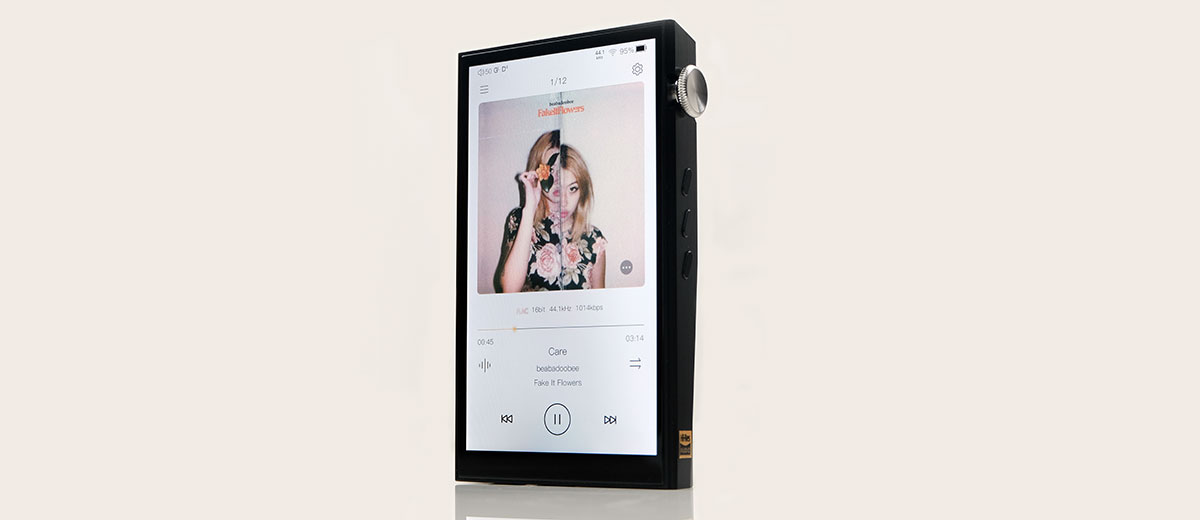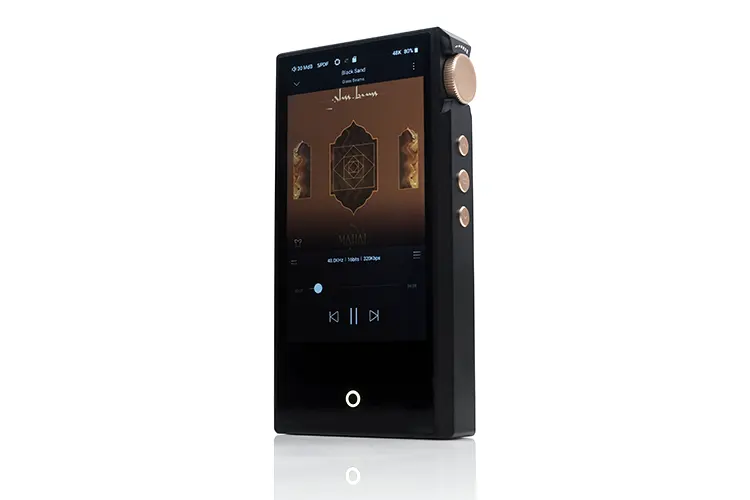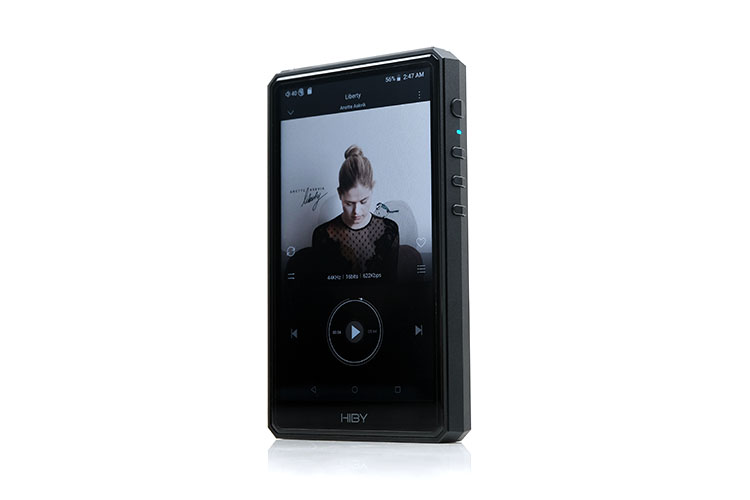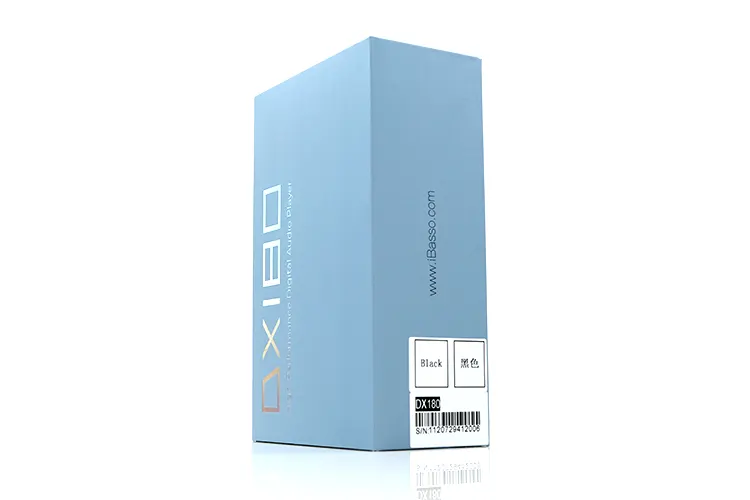Selected Comparisons
The following comparisons to the DX180 were completed using a mix of the Sennheiser IE 600, the Campfire Audio Fathom, and the THIEAUDIO Monarch MKIII, all in balanced output low gain mode.
iBasso DX160
The iBasso DX160 was launched in 2019 and was the successor to the DX120. It was also our co-awardee for the same year’s ‘Bang For Buck’ DAP awards.
Technical
I will try to condense this as much as possible considering that much of the comparison work was done earlier in the review.
Suffice it to say the switch to a Snapdragon 665, enhancing the RAM to 4GB, and layering Android 13 on top creates a faster and modern interface on the DX180. Side by side the Android 8.1 DX160 shows its age subjectively with a stuttering performance switching from app to app or scrolling through the media artwork.
The gap between the actual DAC chipset choices is not huge. The CS43131 is not a high-end version of the DX160’s CS43198, they’re the same except the CS43131 has an integrated amp at its disposal.
The key difference is the FPGA Master 2.0 digital processing in the DX180 combined with the Quad-DAC implementation instead of dual DAC producing at least 2-3 dB better SNR performance over the older unit.
The DX180 is also a more capable performer for decoding at PCM 32BIT/768kHz and DSD512 compared to the DX160’s PCM 32BIT/384kHz and DSD256 capability. Bluetooth 5.0 LDAC decoding is similar in both.
It’s a bit trickier to compare amplification milestones for the two DAPs. Back then iBasso measured output purely on Vrms without specific load weighting. The DX160 has slightly more voltage but a more limited current output.
I had previously confirmed that the DX160 was 136mW balanced into a 300Ω load and on lower loads, it is lower than 500mW. The 690mW into a 32Ω load for the DX180 is higher than before but the 300Ω is just marginally behind at 120mW (6Vrms).
Design
I prefer the comfier handling of the smaller DX160’s rounded curves, however, the DX180’s taller multifunctional rotary volume dial and faster OS make it a much better user experience.
Both devices can be operated single-handed, however, the additional swiping gesture system of Android 13 makes it a little easier to navigate the DX180 one-handed.
More heat is generated from the DX160 during use, primarily due to the DX180’s more capable CPU and RAM meaning less thermal throttling and less heat generated.
Both DAPs use a 3200mAh but the DX160 version is non-user-replaceable and rated at 13 hours instead of 15 hours on the DX180. The DX160 is optimal on the 720P screen display for heat and battery life meaning you will not get 13 hours on 1080p which is the default resolution on the DX180.
Save for the switch of the microSD card to the top panel the I/O on the DX180 is unchanged from the DX160 meaning dual functional 4.4mm and 3.5mm sockets to the base and USB-C on the top.
The power button from the DX160 is now incorporated into the multifunctional rotary dial of the DX180, much like the DX240.
Impressions
The tonal differences here are not huge. Both have a natural to neutral sound signature with a bit of welcome density on the lows and a relatively neutral set of highs.
What I am hearing is an enhanced level of refinement and superior resolution from the DX180 performance, particularly in how it manages space and the complexity of its imaging.
I suspect the kingmaker in this is the upsampling capability within the FPGA combined with the quad-DAC decoding which is spitting out a more complete reproduction of what it receives.
You can hear it, particularly in the characterization and detail of the note texture and how pleasing the resulting definition of instruments and vocals become.
For example, with the Campfire Audio Fathom in a balanced low-gain configuration, the DX160 came across as more 2-dimensional in its soundstage, with notes a little blander in texture and offering slightly less detail. Overtones were less refined with natural sibilance a bit edgier when brought into play.
The DX180 will not dull down on natural sibilance but it breaks it in a more pleasing manner sounding a little less pointed and sharp in its delivery. The decay in the notes also came across as a bit tighter with the resulting space around and behind the notes more noticeable.
Dynamic range has improved in the process so the quick ‘in and out’ of the notes had more impact with the DX180 whereas the DX160 tended to sound more blended with less momentary space to break up a flurry of tightly packed instrumental notes.
That improved my perception of how the imaging played out with this pairing creating a more layered and interesting sound on the DX180 compared to the DX160’s more simplistic presentation.
Cayin N3ULTRA
The Cayin N3ULTRA has been in my office for the last few weeks so there is no official review yet. You can expect that in the coming weeks. Some aspects of this analysis might change in the final full review.
Technical
The N3ULTRA should be considered a pure music player despite its Android backend.
The setup here is more akin to a closed-wall skinned older Android system with no wireless connectivity and a Snapdragon 425 SoC and 2GB of RAM inside the N3ULTRA to keep it running smoothly.
The N3ULTRA has a single external memory card slot and USB-OTG flash expansion with no onboard storage compared to 128 G inside the DX180.
Unlike the DX180, there is no WiFi, no BT, and no app capability for the N3ULTRA. Everything is about local playback with the USB-DAC and a line-out as the only way to link to external devices.
For those of you coming from an N3Pro or want that pure tube sound then a lot of the N3ULTRA functionality is familiar territory. For those wondering which to get and if you need connectivity and app expansion, the open Android DX180 is the way to go.
On the decoding and output side, this is where things are more aligned. The N3ULTRA uses a dual AK4493SEQ DAC capable of matching the DX180 for decoding up to DSD512 and PCM 32BIT/768kHz. Both devices can bypass SRC for bitperfect playback.
At up to 600mW from its Raytheon JAN6418 or solid-state balanced output, the N3ULTRA also comes close to the DX180 690mW performance. Both should be more than capable of driving similar types of headphones and IEMs.
Just bear in mind the N3ULTRA uses a tube amplifier output so the SNR ranges of that option are between 113 dB (tubes) and 120 dB (solid-state) depending on the output.
That is a lot lower than the DX180’s 127 dB – 133 dB range. I doubt tube enthusiasts will be swayed by that though, it’s just the nature of the beat when using tubes.
Design
The N3ULTRA is as tall and deep as the DX180 and weighs almost the same at 204g compared to 206g. However, it is significantly narrower with a smaller 4.1” 720p TFT touchscreen which doesn’t have the same visual pop or borderless bezel design as the 1080p 5″ screen of the DX180.
I suspect one of the benefits of not being tied to an open Android system is being able to craft a device that does not need a huge LCD screen for flexible app compatibility. It does feel easier to operate single-handed than the DX180 and the volume dial has a smoother ‘clicky’ action.
For a gimped Android OS, the N3ULTRA’s user experience is slick enough and easy to understand. It looks like the silent hand of HiBy is creating some magic here with a skin of their OS on top of Android and many audio settings that mirror that of HiByMusic such as Exclusive HQ USB audio access mode.
The N3ULTRA microSD slot is on the left panel and yes, its case covers it so another nice example of why a top panel card slot is quite useful. Cayin has done away with the multifunction aspect of the N3ULTRA dial with a power/screen switch on the top panel.
All the I/O on the N3ULTRA is at the base. It has a dedicated single-ended LO and PO with dual functional balanced PO/LO whereas the DX180 has dual functionality for 3.5mm and 4.4mm hence just 2 ports. Coaxial is handled via USB-C on the Cayin and the 3.5mm PO on the DX180.
Impressions
There are three different sound signatures with the N3ULTRA so I will quickly go over each one here relative to the DX180.
For the solid-state tuning, the DX180 shows a bit more dynamic range, sounding more energetic and upfront in its tuning. The N3ULTRA alternative is more relaxed and more intimate, with slightly more warmth in the lows but not as ‘driven’ sounding as the DX180.
Mind you, I am not 100% sure people will buy the N3ULTRA for a solid-state mode, it’s more about the tube sound which is where the major differences will come through.
The Classic timbre mode is a bit deeper-sounding than the DX180, fuller on the sub-bass but with less mid-bass punch and urgency. This came through with the IE 600’s dynamic driver more than the Fathom’s BA setup.
There is a distinct hall-like or atmospheric quality to the N3ULTRA Classic soundstage, particularly through the mids where vocal imaging is marginally more relaxed in its positioning relative to the DX180’s more upfront and firmer midrange focus.
The modern timbre mode sits somewhere in between Classic and solid-state modes with more of a driven firmer mid-bass tone and slightly more presence in the highs to go along with it.
Of the three modes, it comes closer to the urgency of the DX180 lows but some longer decay trails and a slightly sweeter sparkling overtone in the upper-mids give away its tube traits.
Just as a small addendum, the noise floor of the N3ULTRA is slightly higher on both tube modes using sensitive IEMs. The background is not as black as the DX180 performance with a very slight waterfall hiss at low volume using sensitive IEMs.
HiBy R5 Gen 2
The HiBy R5 Gen 2 was released in mid-2022 and is the company’s equivalent midrange DAP with the recently reviewed R4 from Lynn coming in at half the price.
Technical
Both are compact open Android platforms with Google Play installed out of the box. However, the R5 Gen 2 has an older Android 8.1 OS, 2GB less RAM, and a lower-tier Snapdragon 425 SoC making it the slower of the two DAPs.
Both DAPs are delta-sigma though the R5 Gen 2 is equipped with a dual ES9219C implementation as opposed to a quad CS43131 inside the DX180. This is ironic because up until the R5 Gen 2, HiBy was using CS43198 DACs in their midrange DAPs though in dual DAC configuration only
Decoding is on par with the DX180 for PCM at 32BIT/768kHz maximum but slightly behind for DSD at DSD256 rather than DSD512. Both devices bypass Android’s SRC and output at a bitperfect rate.
The R5 Gen 2 amplifier topology has not one, but two operational modes for its analog output. That means different flavors of sound and different performance numbers.
The first mode is the serious Class A discreet resistor-based push/pull design and is the mode I will be comparing to the DX180. The second ‘eco mode’ is an SoC-driven from the DAC and to be honest it’s just there to extend the R5 Gen 2 battery life such is the drop in performance.
At max output, the R5 Gen 2 Class A mode is still a bit behind the DX160 at 475mW and 3.9Vrms balanced compared to 690mW and 6Vrms making the iBasso unit a bit more flexible for more demanding headphones. Both will have no issues with IEMs, it’s more a question of noise floor on this basis.
Design
The R5 Gen 2 is the smaller DAP but there are pros and cons with the R5 Gen 2 more pocketable and the larger brighter screen of the DX180 easier to read and use.
The more substantive design difference is how easy that screen is to navigate and how smooth the animation is during navigation.
The better CPU and RAM of the DX180 means faster browsing, and the Android 13 over Android 8.1 makes it more aesthetically pleasing to browse.
I/O placement is different on the R5 Gen 2 with analog and digital at the base of the DAP and the memory card on the left side panel. It also has a dedicated 2.5mm TRSS LO for its balanced output, which the DX180 lacks.
The R5 Gen 2 is a good example of why the top placement of the card slot on the DX180 is preferable as the supplied stock case has no opening to access the card.
I am on the fence about whether the DX180 rotary dial is better than the R5 Gen 2 dual button control on the left panel. I think this is a preference thing since both are digital volume systems.
The R5 Gen 2 has a larger 4500mAh but is not user-replaceable and has a shorter life cycle in Class A mode of 10 hours versus 15 hours.
You can go much further in eco-mode at up to 35 hours which is way beyond the DX180’s rated 15-hour battery life but the SoC amplifier performance is noticeably inferior.
Lastly, 128 GB of onboard memory at this price point is class-leading for the DX180. The R5 Gen 2 does not even come close with just 16GB onboard memory.
Impressions
On initial impressions with the Fathom and the Monarch MKIII, the R5 Gen 2 will have a stronger weight on the lows and a generally fuller tone up to the mids when compared to the DX180.
However, the DX180 is more detailed sounding, with better dynamic range, and an airier more complex soundstage.
Again, this might be related to how capable their respective upsampling capabilities are pre-DAC but I just get a strong impression that the DX180 is pushing out more information with every note regardless of where it’s imaging.
For example, with the Monarch MKIII, yes you get more power on the lows from the R5 Gen 2, that’s its tuning and the DX180 will not out-rumble it. However, it’s a softer delivery elsewhere with background notes less distinguished or defined and lacking in clarity.
The R5 Gen 2 is more front and center with the Monarch MKIII so it’s all vocal and bass to some extent with the background arrangements softer and fuzzier. It’s more bombastic but less nuanced.
The DX180 is more neutral in vocal and bass placement, punchier on the MKIII mid-bass, and tighter sounding in general. More than that, faint notes on the periphery are clearly defined, giving it better height, width, and more perceived space through the mids.
The separation is thus a notch up in my opinion when compared to the R5 Gen 2 which becomes more obvious with balanced armature driver IEMs such as the Fathom which are less bass-reliant.
With a less forced vocal image, the overtones are also more pleasing with the DX180’s presentation out of both IEMs.
My Verdict
The iBasso DX180 is a very accomplished and natural-sounding Android 13-equipped digital audio player that won’t break the bank price-wise which is always something to cheer on these days.
It is perky enough with decent RAM, and some solid AnTuTu results, and comes with Google Play out of the box meaning no hiccups with Plays services with your favorite apps.
Mango Player’s PEQ is still my favorite system of its type, so easy to use and can be a game changer for fussy pairings.
The new Mango OS looks nicer, but its change in UI might prove polarizing depending on how wedded you are to the older version. The loss of ‘double-tap to wake’ might also put off smartphone users.
I can forgive the above though because the performance is a significant step up my older iBasso mid-fi DAPs, particularly in deeper staging capability. Throw in a user-replaceable battery and you should have a competitive DAP that will last you a very long time.
iBasso DX180 Technical Specifications
- Color: Dark Night Black, Pine Green, Meteor Blue
- Body material: Aluminum alloy
- Display: 5.0-inch IPS screen, 1080*1920 resolution, with on-cell capacitive touchscreen
- USB connection: Type-C USB 3.1 (high-speed data transmission and fast charging)
- Output: 4.4mm balanced headphone output, 3.5mm single-ended headphone output; 4.4mm linear output; 3.5mm linear output; 3.5mm coaxial output
- WiFi: 802.11b/g/n/ac (2.4Ghz/5Ghz)
- Bluetooth: V5.0
- Storage: 4G RAM + 128G ROM, 3G RAM + 32G ROM, expandable Mirco SD (TF) card slot
- Battery: 3200mAh 3.8V lithium-ion polymer battery
- Charging time: about 1.5 hours
- Playing time: low-gain balanced output 15.5 hours, high-gain balanced output 13 hours, Line Out 30 hours
- Size: 123*75*16mm
- Weight: 206g
4.4mm balanced headphone output
- Output level: 4Vrms (Low Gain) 6Vrms (High Gain)
- Output power: 690mW + 690mW@32Ω, distortion <0.1%
- Frequency response: 10Hz~75kHz 1dB
- Signal-to-noise ratio: 133 dB
- Dynamic range: 133 dB
- THD+N: -121dB (A-wt, 600ohm load)
- Separation: -144 dB
- Impedance: 1.1Ω
3.5mm single-ended headphone output
- Output level: 2Vrms (Low Gain) 3Vrms (High Gain)
- Output power: 281mW + 281mW@32ohm, distortion <0.1%
- Frequency response: 10Hz~75kHz-10 dB
- Signal-to-noise ratio: 127 dB
- Dynamic range: 127 dB
- THD+N: -116dB (A-wt, 600ohm load)
- Separation: -118 dB
- Impedance: 0.6Ω






